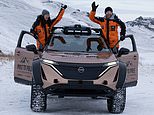
If range anxiety is putting you off the idea of owning an electric vehicle, pause for thought for one married couple planning to embark on a 17,000-mile trek in their battery-powered car starting next month.
Meet husband and wife adventurers, Chris and Julie Ramsey from Aberdeen.
They are taking their modified electric Nissan Ariya – based on the Japanese brand’s new fully electric SUV that costs from £46,000 – on a world-first EV expedition beginning at the Magnetic North Pole and concluding thousands of miles – and almost a year – later at the South Pole.
The 10-month journey will be a monumental test of the car, and possibly their marriage.
Based on the vehicle’s battery range, the husband and wife would – in theory – need to pull over to charge at least 54 times on their journey. But the truth is they’ll be stopping to charge far more often than that…
The ultimate test of an EV…and a marriage: Julie, 44, and Chris, 46, Ramsey will attempt a 17,000-mile schlep from Magnetic North Pole to the South Pole in this modified electric Nissan Ariya, which uses the drivetrain from the SUV you can buy in dealers
For many married couples, the thought of spending March through to January almost non-stop in a car with their spouse would be an agonising one.
And if 10 months, 17,000 miles and 14 countries sat next to one another wasn’t enough to test their 22-year- relationship, the pair are embarking on the journey in an electric car with a limited battery range.
The adventure-readied vehicle the wedded pair will be using is set to transport them from the Arctic through North, Central and South America, before crossing to Antarctica.
This is the first time a vehicle of any type has attempted the ‘Pole-to-Pole’ challenge, with no combustion-engine car ever completing the same voyage.
The terrain won’t be easy, which is why this EV has been specially adapted.
But while it might look like a hulking monster truck at first sight, the car is based on the Nissan Ariya crossover that will soon be appearing in UK showrooms.
And it uses the standard vehicle’s drivetrain.
The expedition car features an 87kWh battery pack (the larger of two options available with the electric Nissan), which – in conventional form – offers a range of up to 319 miles on a full charge.
That means the couple would – based on this range claim – need to stop to recharge at least 54 times to fully charge the batteries to cover the enormous schlep from the top to the bottom of an atlas.
The Ariya (left) is Nissan’s first all-electric SUV model. Prices start from £46,145 in the UK. The modified version (right) Chris and Julie will be driving for 10 months solid has the larger 87kWh battery – prices for this model start at just under £55,000
The adventure-readied vehicle the wedded pair will be using is set to transport them from the Arctic through North, Central and South America, before crossing to Antarctica
The voyage is scheduled to begin in March and likely won’t see the pair reach the South Pole until January 2024. That’s 10 months of travelling in a car together. With long journeys typically a pressure cooker for many couples, this is a big test
This is the first time a vehicle of any time has attempted the ‘Pole-to-Pole’ challenge, with no combustion-engine car ever completing the same voyage
However, the 319-mile claimed range in reality will be somewhat shorter.
As is the case with petrol and diesel cars, the official figures are not quite the same as what’s achievable in the real world.
Add to the equation lots of time spent driving in sub-zero temperatures (which will limit the efficiency of the battery), challenging landscape and the addition of some extreme off-road modifications and the chances of achieving 319 miles between charges is exceptionally thin indeed – impossible, in fact.
Among the changes made to the car is the addition of heavy long-travel off-road suspension and chunky 39-inch tyres, both of which will put an extra strain on the battery and reduce the claimed range figure.
Modifications were made to the Ariya by specialist British firm Artic Trucks, which had to expand the wheel arches of the standard Nissan to allow for the massive wheels and tyres to fit without rubbing on panels, which also effectively shortened the vehicle’s front and rear overhangs – meaning it should be able to cope with steep inclines and declines without the bumpers being snared on boulders and harsh terrains.
But the pair won’t need to find a public charging point in the middle of nowhere when the battery begins to run low.
That’s because they will be hauling a renewable energy unit they will use to charge the Ariya in the polar regions.
During this epic adventure, which aims to kick off next month, the Ariya will need to cope with ice fields, deep snow, steep mountain climbs and inhospitable desert dunes
Among the changes made to the car is the addition of heavy long-travel off-road suspension and chunky 39-inch tyres, both of which will put an extra strain on the battery and reduce the claimed range figure
The expedition car features an 87kWh battery pack (the larger of two options available with the electric Nissan), which – in conventional form – offers a range of up to 319 miles on a full charge…
That means the couple will need to stop to recharge at least 54 times in total to cover the enormous schlep from the top to the bottom of the atlas. The pair are scheduled to have a shakedown test in Canada before the adventure kicks off next month
The portable prototype includes a packable, lightweight wind turbine and solar panels that will take advantage of high winds and long daylight hours to provide charge for the EV’s battery.
The charging speeds capable are not yet known, says Nissan, though the team behind it will be putting it through initial tests from next week before the married couple try it for themselves in a shakedown run in Canada in March ahead of the start of the expedition.
A charge from 20 to 80 per cent in a conventional Ariya EV can take as little as 40 minutes using a rapid device, though Nissan doesn’t expect the portable unit to provide these charging speeds.
It also needs to be considered that colder climates mean ‘charging times and speeds can be impacted’, says Nissan – which doesn’t bode well when you’re travelling from the North to the South Pole.
While the power station means they can charge where and when they want, it will be another drag on the drivetrain that will reduce the battery’s range.
However, the couple won’t simply be charging overnight for long periods as most electric car owners do in Britain.
Instead, they will drive a few hours then stop to rest and boost the battery.
When they do this will also depend on the terrain they encounter and time it takes to clear it, as well as the weather and other factors.
But the pair won’t need to find a public charging point in the middle of nowhere when the battery begins to run low. That’s because they will be hauling a renewable energy unit they will use to charge the Ariya in the polar regions
The portable prototype includes a packable, lightweight wind turbine and solar panels that will take advantage of high winds and long daylight hours to provide charge for the EV’s battery
The couple estimate they will be spending 12 to 13 hours per day in the car together, which will be a monumental test of their endurance…and potentially their tolerance for one another as they prepare to spend 10 months at the wheel
During this epic adventure, which aims to kick off next month, the Ariya will need to cope with ice fields, deep snow, steep mountain climbs and inhospitable desert dunes.
Temperatures will range from minus 30 degrees to exceeding plus 30 at times.
Speaking at the electric vehicle’s official unveiling this week, Chris, 46, a Guinness World Record holder and self-professed electric vehicle adventurer, said the aim is to showcase the capabilities of electric vehicle in a hope to accelerate adoption to battery cars.
‘One of the things that underpins all the adventures we do is that we take a standard production EV and aim to make minimal changes to clearly demonstrate its real, everyday capabilities, regardless of where you are driving it.
‘Our Nissan Ariya is no different as the vehicle’s drivetrain and battery has remained factory standard, demonstrating just how capable and versatile the production Ariya is.
‘We’ve modified the suspension and widened the wheel arches so we can benefit from the stable platform and support of the 39-inch BF Goodrich tyres.
‘I’m incredibly excited to get behind the wheel of what was already a brilliant vehicle, but now feels equipped to take on the ends of the earth in style!’
As a self-confessed coffee lover, Chris will have access to an espresso machine that’s integrated into the boot.
While this will provide the pair with a good supply of sustainable coffee, it also will likely be another drain on the battery and shorten the range.
There is also a launch pad on the roof for a drone so that Chris and Julie can capture footage of their incredible trip en route and their own weather station technology so they can plan their trip based on the conditions.
The car is equipped with its own weather station so the married couple can plot their journey based on the conditions. It also has a drone launch pad on the roof so they can capture incredible footage while on their monumental trip
Speaking about the trip, Julie said: ‘It will be challenging for sure’. Chris, a Guinness World Record holder and self-professed electric vehicle adventurer, said the aim is to showcase the capabilities of electric vehicle in a hope to accelerate adoption to battery cars
For many married couples, the thought of spending March through to January almost non-stop in a car with their spouse is an agonising one. This is Money wishes Chris and Julie all the best ahead of their huge trek
The couple estimate they will be spending 12 to 13 hours per day in the car together, which will be a monumental test of their endurance…and potentially their tolerance of one another as they prepare to spend 10 months at the wheel.
‘It will be challenging for sure,’ Julie,44, said.
She has left her full-time job in the oil and gas industry (the same sector in which Chris also previously worked) to concentrate on the expedition.
Speaking at the reveal of the modified Ariya, she added: ‘The planning and preparation for Pole-to-Pole has been such a big part of our lives over the past four years so I am really looking forward to getting the expedition underway in March.
‘We’re going to discover so many interesting initiatives from communities and individuals who are taking positive action against climate change and I’m looking forward to sharing these experiences and stories with everyone.
‘We are doing something that has never been attempted before, a world-first, and ultimately that is what makes it so exciting.’
VIDEO
ELECTRIC CAR VIDEOS
Some links in this article may be affiliate links. If you click on them we may earn a small commission. That helps us fund This Is Money, and keep it free to use. We do not write articles to promote products. We do not allow any commercial relationship to affect our editorial independence.
Source link
CHECK OUT: Top Travel Destinations
READ MORE: Travel News



